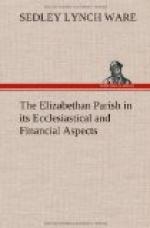CHAPTER I.
THE ECCLESIASTICAL GOVERNMENT OF THE PARISH.
The ecclesiastical administration of the English parish from the period of the Reformation down to the outbreak of the great Civil War is a subject which has been much neglected by historians of local institutions. Yet during the reign of Elizabeth, at least, the church courts took as large a share in parish government as did the justices of the peace. Not only were there many obligations enforced by the ordinaries which today would be purely civil in character, but to contemporaries the maintenance of the church fabric and furniture appeared every whit as important as the repairing of roads and bridges; while the obligation to attend church and receive communion was on a par with that to attend musters, but with this difference, that the former requirement affected all alike, while the latter applied to comparatively few of the parishioners.
In the theory of the times, indeed, every member of the commonwealth was also a member of the Church of England, and conversely. Allegiance to both was, according to the simile of the Elizabethan divine, in its nature as indistinguishable as are the sides of a triangle, of which any line indifferently may form a side or a base according to the angle of approach of the observer[1]. The Queen was head of the commonwealth ecclesiastical as well as of the commonwealth civil, and as well apprized of her spiritual as of her temporal judges[2]. For both sets of judges equally Parliament legislated, or sanctioned legislation. Sometimes, in fact, it became a mere matter of expediency whether a court Christian or a common law tribunal should be charged with the enforcement of legislation on parochial matters. Thus the provisions of the Rubric of the Book of Common Prayer were enforced by the justices as well as by the ordinaries. Again, secular and ecclesiastical judges had concurrent jurisdiction over church attendance, and—at any rate between 1572 and 1597[3]—over the care of the parish poor. Finally, it must not be supposed that the men who actually sat as judges in the archdeacon’s or the bishop’s court were necessarily in orders. In point of fact a large proportion, perhaps a large majority of them, were laymen, since the act of Henry viii in 1545 permitted married civilians to exercise ecclesiastical jurisdiction.[4]
In the treatment of our subject the plan we shall follow is, first, to make some preliminary observations as to the times, places and modes of holding the church courts; second, with the aid of illustrations drawn from the act-books of these courts, to show how their judicial administration was exercised over the parish, either through the medium of the parish officers or directly upon the parishioners themselves; third, to analyze the means at the command of the ecclesiastical judges to enforce their decrees; and, finally, to point out that from its very nature the exercise of spiritual jurisdiction was liable to abuses, and must at all times have proved unpopular.




